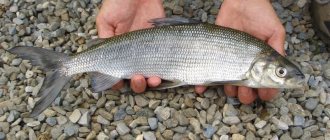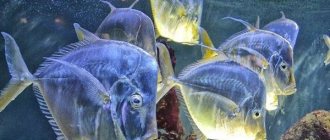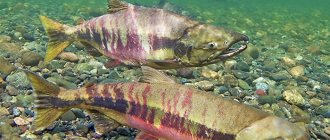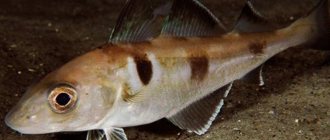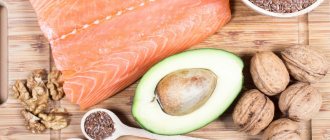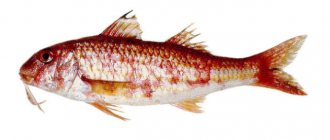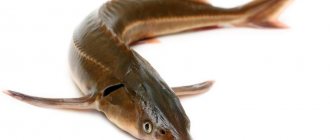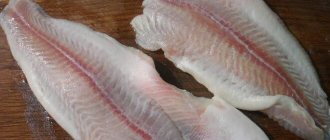Among all sea salmon fish, sockeye salmon is considered the most delicious. Let's figure out what kind of fish is sockeye salmon, how it differs from other migratory representatives of the salmon family, what it eats, what its beneficial properties are and what kokanee is.
Do you like fish dishes?
- Yes 96%, 6501 votes
6501 votes 96%6501 votes - 96% of all votes
- No 3%, 186 votes
186 votes 3%
186 votes - 3% of all votes
- I don't eat fish 2%, 108 votes
108 votes 2%
108 votes - 2% of all votes
Total votes: 6795
01.09.2020
×
You or from your IP have already voted.
Description and appearance
Sockeye salmon grows up to 80 cm in length. The weight of fish sold for sale is only 1.5-3.5 kg before gutting, and males are noticeably larger than females. The largest sockeye salmon caught weighed 7.7 kg. Scientists noted that the larger the size of the fish, the deeper the spawning ground it hatched.
The fish returns to fresh water bodies where they hatched from eggs at 6-7 years of age. Here the first important difference between sockeye salmon and other salmon is noticeable: it most often spawns not in river waters, but in lakes, next to the springs that feed them. Usually the fish not only enters the same lake, but also chooses the same spawning ground where it was born.
During the feeding period, that is, life in the ocean while growing up and fattening, the description of sockeye salmon looks similar to chum salmon: compare their photos. Both fish are approximately the same size, color, they have similar behavior (almost the only difference is that chum salmon spawn in river water) and live in the same places. During this period, they can only be reliably distinguished by the number of gill rakers: chum salmon has 18-28, sockeye salmon has more than 30 pieces.
The popular name for sockeye salmon is Krasnitsa. It appeared not because of the meat, but because of the appearance of the fish. When the fish begins its final journey to the places where spawning has been taking place for centuries, the sockeye salmon's scales turn from steel-silver to red, and only the head turns green (see photo). Males develop a pronounced hump.
Sockeye salmon spawn from May to early July, and the fry hatch only in January. Six-month-old juveniles rarely go to sea; usually the fish live in the lake for 2-3 years, and only then go down to feed, which lasts from 1 to 4 years.
Methods for preparing sockeye salmon
Due to the fact that sockeye salmon meat has a specific taste and acceptable fat content, a lot of different dishes can be prepared from it. There are simple and accessible recipes for this.
Balyk from sockeye salmon
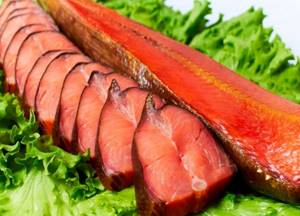
- To prepare sockeye salmon balyk you need to have a whole fish carcass, which is cut up with the head, tail and fins removed. Then the fish is thoroughly washed under running water. After this, the carcass is cut into 2 parts and the backbone and bones are removed.
- Rub two halves of fish generously with coarse salt, at the rate of 80 grams per 1 kilogram of fish. After this, the 2 halves are joined together and placed in a waffle towel, tied with strong rope or twine. Then the fish is placed in the refrigerator for 5 days. This process dehydrates the fish and thickens the meat.
- After this period, the fish is taken out and excess salt is removed by wiping with a damp cloth. To make the taste more interesting, the pieces of fish are cut and pieces of garlic are stuffed into the cuts.
- The next stage is drying the fish, which is carried out in a suspended state for 4 days. If the fish meat is lubricated with vegetable oil every day. This will give it a more pleasant appearance.
- Balyk is considered ready to eat if, when you press on it, droplets of fat begin to appear.
BALYK, classic recipe, preparing real balyk from red fish, salmon balyk
Sockeye salmon under a cheese cap

- 1 kilogram of sockeye salmon fillet is cut into equal pieces, which are evenly covered with salt and pepper, with the addition of olive oil and lemon juice. Grease the baking dish with the same oil. Preheat the oven to 220 degrees in advance, after which the fish is placed in it for 7 minutes.
- While the fish is baking, the cheese cap is being prepared. To do this, beat 3 egg whites with the addition of 200 grams of cheese.
- After this, pieces of fish are covered with the prepared mixture, and it continues to bake for another 10 minutes.
- Once cooked, the fish is served with lemon and dill.
Grilled sockeye salmon

- Take sockeye salmon fillet and cut it into cubes 3-4 centimeters in size, after which they are laid out in layers in an enamel bowl. After each layer, add lemon, garlic, basil to the bowl and pour over soy sauce, and add salt and pepper. The pieces are marinated for 2 hours.
- To determine the degree of heating of the grill surface, just spray water on it. If the water bounces off the surface, then you can cook the fish. The pieces are laid out on the surface and pressed down, for example, with a pan lid. The degree of readiness of the fish can be indicated by bright stripes left by the relief surface of the grill.
- After frying the pieces on the grill surface, they are placed in the oven for 10 minutes at a temperature of 200 degrees. This method of preparation is absolutely harmless to human health, and the fish does not lose its beneficial properties.
Grilled red fish recipe
Sockeye salmon cooked on coals
The most delicious dishes are those prepared in nature. This is due to several reasons. The first reason is related to clean, natural air, which helps awaken the appetite, which cannot be said in a city. And the second reason is the presence of a peculiar aroma that coals emit in nature, especially since they are of natural origin.
It is doubly pleasant if trophy sockeye salmon, freshly caught from a reservoir, is cooked in nature. Possessing bright taste characteristics and combined with natural aromas, it does not require the use of any refined seasonings. Under such conditions, sockeye salmon meat is ideal for cooking over charcoal.
- The cut, gutted and washed fish is cut into steaks no larger than 2 cm in size. After this, the steaks are placed in a bowl with onions, lemon and dill. If the fish is fresh, then you can do without salt. In such conditions, the fish is marinated for about half an hour.
- While the fish is marinating, the coals are prepared, evenly distributed over the surface. The fish is placed on the grill and cooked for 8 minutes on each side. During frying, the fish is sprinkled with lemon juice. Once the steaks have acquired a pleasant golden hue, the fish is ready to eat.
Sockeye salmon is listed in the Red Book. This is due to its uncontrolled fishing, as well as environmental conditions worsening every year. Poachers cause great damage to the population, which is also due to its excellent taste characteristics.
Igor 11/13/2017
Habitat and food type
Sockeye salmon is a Pacific salmon. It is found throughout the northern part of the Pacific Ocean, from Alaska to California on the West Coast and from Hokkaido Island to the Anadyr River on the East Coast.
The main habitat of sockeye salmon in Russia is the Kamchatka coastal waters, but fishing is possible off the coast of Chukotka and in the Sea of Okhotsk.
If there is a sufficient amount of food in the lake where sockeye salmon lives, some of the fish do not go to the sea, but remain to live in the lake until spawning. Such fish can be found in the USA, Canada, Japan, and in Russia - in Kamchatka. This form is called kokanee. It does not look as bright as an anadromous one, because its diet does not contain calanid sea crustaceans.
The main food of sockeye salmon is calanid crustaceans. They contain carotene pigment, which passes into sockeye salmon and colors its meat a rich red color. This phenomenon occurs in the animal world. Initially off-white flamingos have pink plumage for the same reason.
Food determines not only the color of the meat, which fundamentally distinguishes sockeye salmon from other representatives of the salmon family, but also its fat content.
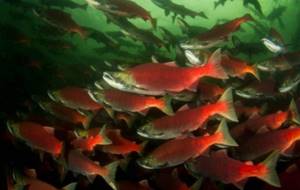
Potential Harm
Contraindications:
- Exacerbations of gastrointestinal diseases, especially gastritis, stomach and duodenal ulcers.
- Children under 5 years of age (high risk of food allergies).
- Diseases of the blood coagulation system (use is possible only after consultation with a specialist).
Attention! Pregnant women should eat sockeye salmon in limited quantities, as it may contain dangerous mercury compounds.
The product can be harmful to health for the following reasons:
- Fish accumulate dangerous toxins, the concentration of which increases during the spawning period due to changes in hormonal levels.
- Sockeye salmon are susceptible to infection by parasitic worms, so careful heat treatment plays an important role.
Navaga: harm.
Calorie content
In 100 g of raw Kamchatka sockeye salmon there are 157 kcal, BJU is 20.3 grams of protein and 8.4 grams of fat. The product does not contain carbohydrates.
If you bake fish, its calorie content will remain unchanged, but the fat content will change: there will be more protein (26.5 g) and less fat content (5.6 g). This happens because when baking, water leaves the product and fat is rendered.
When cooked by cold smoking, the fish becomes fattier and higher in calories (206 kcal, 29 g protein, 20 g fat). Hot smoking, on the contrary, makes the product more dietary (141 kcal, 24.5 g of protein, 4.8 g of fat).
100 g of lightly salted sockeye salmon contains 142 kcal, 21.3 g of protein and 5.6 g of fat.
Culinary certificate
Sockeye salmon makes wonderful balyk and aromatic fish soup. You can bake the whole fish in foil, and prepare delicious cutlets or fish soufflé for children.
During cooking, you can add various seasonings:
- Allspice peas and bay leaves are suitable for cooking.
- For baking in foil, use herbs: rosemary, marjoram, dill and parsley.
- The following go well with fried fish: black pepper, garlic, cumin, fresh lemon juice.
- Steamed fish will turn out especially tasty if you season it with lemon balm, cloves and basil.
Chemical composition
Sockeye salmon meat is exceptionally rich in vitamin B12 (cobalamin), 100 g of product contains 7.82 mcg, with the daily requirement for an adult being 3 mcg. This is 261% of how much vitamin an adult should consume. It also contains a lot of vitamin D (calciferol) - 11 mcg with a daily requirement of 10, that is, this is 110%. The third place in content is occupied by vitamin PP, it is 9.5 mg or 48% of the daily value.
Phosphorus is the leading macronutrient. Its 210 mg when the norm is 800 mg, this is 26%. In second place is potassium (390 mg at a norm of 2000, 16%), third is chlorine (165 mg at a norm of 2500, 7.2%) and with a slight lag is magnesium (24 out of 40 mg or 6%).
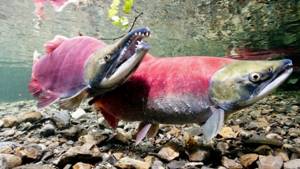
Among the microelements, sockeye salmon contains the most cobalt - 20 mcg with a norm of 10, this is 200% of the daily intake for an adult. Half the amount of chromium (55 mcg or 110%), a lot of selenium (29.9 mcg, 54%) and iodine (50 mcg, 33%).
How to choose fish
- Give preference to chilled or canned product. A frozen carcass may contain chlorine compounds harmful to the body.
- When choosing chilled sockeye salmon, pay attention to the eyes (transparent) and gills (red or pink color - a sign of freshness).
- The smell should be natural fishy, without unpleasant shades.
- The surface of the fresh product is smooth, without mucus or damage.
On a note. Mucus-covered fish with cloudy eyes, an unpleasant “smell” and darkened gills are unsuitable for food.
Beneficial features
The benefits of krasnitsa as a dietary product are striking, especially when baked. The basic characteristics of sockeye salmon meat are low calorie content, an abundance of easily digestible protein and healthy fats. Fish oil contains almost no low-density cholesterol, which harms blood vessels by depositing on their walls. But there are a lot of unsaturated and polyunsaturated fatty acids, which reduce the amount of “bad” cholesterol in the blood, protect blood vessels, participate in the production of cell membranes and are necessary for healing the body, maintaining beauty and youth.
The rich chemical composition characteristic of sea fish of the salmon family complements the benefits of sockeye salmon and makes it an important component of a complete diet.
Vitamin B12 is necessary for hematopoiesis. It is useful for any neurological diseases, from back pain to attention deficit disorder. It is also necessary for proper cell division; it helps with the division of nucleic acids. Actively participates in metabolism. It is synthesized within the body and, like many vitamins, it is synthesized by the intestinal microbiota, but this is not enough. It is important to ensure that cobalamin enters the body in sufficient quantities with food.
Vitamin D is needed for the proper metabolism of phosphorus and calcium. With its deficiency in adults, bones can become too fragile, losing calcium. Children with a lack of this substance develop rickets.
Phosphorus is part of bone tissue and teeth, ensuring their strength. But it also has lesser-known functions. It is part of cell membranes and is part of ATP, a compound responsible for energy metabolism in the body.
Potassium is responsible for the rest of nerve fibers after a signal passes through them and is involved in muscle contraction, including the main one - the heart.
Chlorine is necessary for signal transmission between cells of the nervous system. Participates in the digestion process as a component of gastric acid.
Magnesium is part of bone tissue and is involved in the transmission of nerve impulses. Its task is to prevent overstimulation of the nervous system. It is part of many substances involved in metabolism.
Cobalt is needed to create red blood cells. If there is a lack of it, the intestinal microbiota will have nothing to create vitamin B12 from.
Chromium is a component of DNA and RNA - nucleic acids in which the development of the body is encoded. It removes excess cholesterol from the blood, regulates glucose levels, increases muscle strength and removes radionuclides and heavy metal salts.
From iodine, the thyroid gland produces hormones that control metabolism throughout the body. Without it, all processes in the human body slow down.
Selenium plays the role of an antioxidant in the body.
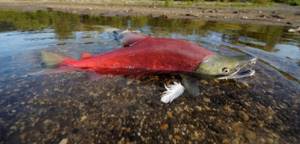
Heavy metals
Industrial waste often ends up in the environment. Toxic mercury compounds pose a danger. They end up in plankton, which the sockeye salmon feed on. The longer a fish lives, the more heavy metals it accumulates. In this regard, doctors recommend limiting the consumption of sockeye salmon caught in the ocean.
- When a person is poisoned by mercury, they experience symptoms of chronic fatigue.
- Children may experience developmental delays.
- Pregnant women should not eat ocean fish in large quantities. Mercury has teratogenic properties and can cause fetal developmental disorders, especially in the first trimester.
Fish that is bred on special farms contains fewer heavy metals, but is often loaded with antibiotics and other harmful chemicals.
Calorie content of sturgeon.
Price
In August 2021, in Moscow you can buy wild gutted fresh frozen sockeye salmon without a head at a price of 829 rubles. for 1 kg, package of 1.9 kg frozen pieces - for 2052 rubles. The tail part (good for fish soup) costs 650 rubles. Fresh frozen steaks were offered at prices ranging from 558 to 960 rubles. kg, there were also individual offers (610 rubles for a steak weighing 600 g)
Lightly salted sockeye salmon costs 319 rubles for 120 n or 349 for 150 g.
Sockeye salmon has the smallest caviar of all Pacific salmon. Its diameter is only 4 mm. The shells are soft, there is bitterness in the taste, and there is a pronounced fishy smell. The color is the most saturated compared to chum salmon and pink salmon caviar.
After spawning, the sockeye salmon dies. This is her concern for her offspring: the lakes where these salmon spawn are not rich in nutrients, and the remains of the parent generation guarantee that the young will have something to feed on.
Homemade pickling recipe
Ingredients:
- 1 kg fish without bones,
- 1 tbsp. l. salt,
- 1 tbsp. l. Sahara,
- 1 tsp. spices to taste.
Cooking method:
- Mix all dry ingredients and divide into 2 equal parts.
- Fill the bottom of the container intended for salting fish with the first half.
- Place the fillet on top and cover with the other half.
- Place the container in the refrigerator for two days.
Advice. It is recommended to make balyk from sockeye salmon. Less fatty representatives of the Salmon family, such as coho salmon, are more suitable for salting.
